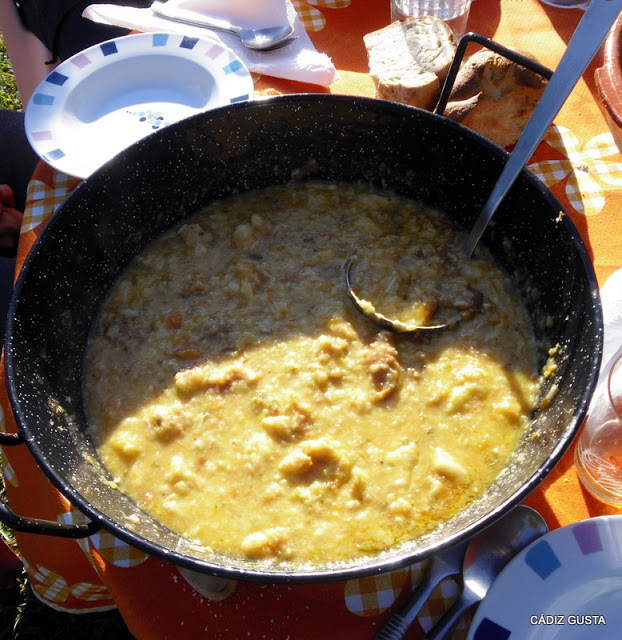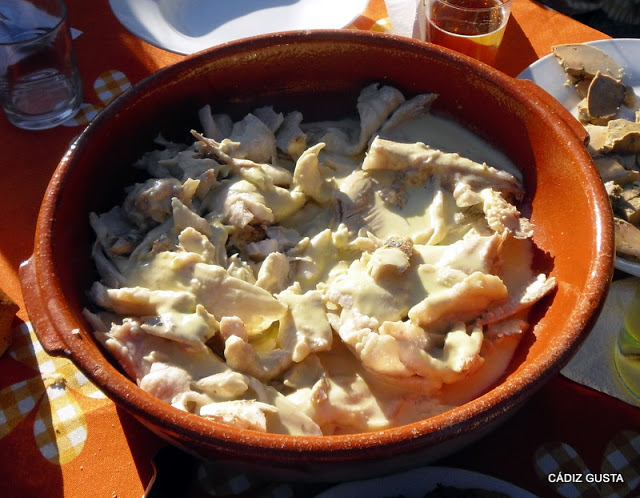Yesterday, a friend of mine asked me if I knew a typical dish of Algeciras (where I was born): the “Abajá”. I told him that I did not know it. Then, he explained me that dish was similar than a seafood soup. I thought that perhaps I could find something about this dish in Internet; and it has been so.
Really, I have found an article, telling about the dish “Abajá” and I want to share with you the explanation. This article has been written by Manuel J. Ruiz Torres. He says the following:
As an introduction to the recipe, I transcribe this article, published in the journal "PubliGuía" No. 1 (June 1997). Interestingly, a few months later, a known writer published "exactly" the same article, adding, as a huge research effort, his own name and omitting only the phrase "I do not know the origin of calling Abajá to this dish", I guess, because he did not it must look reliable display areas of darkness, in his knowledge, a trait of honesty that honors him.
The “Abajá” of Algeciras is primarily a soup. Although you take it on two plates, or overturning, to take it as a second fish, almost dry, after giving their best, to broth where they baked. A fish utilization is equal to that make the Levantine, in their rice a banda, or Murcians, with their cauldron. And like these, the fish need a sauce, to relieve his shroud, to refresh them. Do not be coincidence that, as its Mediterranean relatives, the Abajá sauce is a kind of aioli, enriched, albeit with a bit of self cooking broth.
I do not Know the origin of this dish, called “Abajá”. Lowlanders are the inhabitants of the lowlands, coastal and, by extension, are Southerners. WENCESLADA, that is a vocabulary from Andalusia, defines it, as a soup of Andalusia down, made with water, oil, salt and bread. Related, then, to the Abajao from the Sierra of Cádiz or The Abajá of Arcos, although these are soups with serrano products. As fish soup would have to relate it to some Catalan Suquets (no seafood) or, especially, with bouillabaisse, in Marseille, returning to reveal its Mediterranean origin.
Kitchen ship at sea, where fish, never fixed, is alternating white with blue, and gave exit to the thorniest, previously difficult to sell in the market, even if those who give the best broth. Today, their high prices, lead to prepare Abajá, of a single fish, including sardines or anchovies. And, with them, a durable product as country bread, brown, fluffy, toasted. A loaf to hold your long journey of fishing. A loaf like from Pelayo.
This time, changing the magnificent bread of Pelayo, a neighbourhood of Algeciras, close to the pass of El Bujeo, for also notable bread of Medina, I repeat the recipe that brought us together, around this dish, at each end of the contest in the Falla (a famous Theater of Cadiz), to a group of friends, who had specifically chosen Cádiz to live, without forgetting that part of childhood, that is now called roots. Because it is food to share, with that point of exaggeration and the entertainment, necessary to find out what fish of the assortment, half hidden by the sauce, it is that we are eating in every bite. This time we celebrated Juliet and Sophia, new in our ecofeminist consumer group, “The Nine”. And we did it on the piece, that nature rented us around the garden of vegetables Revolution. From there came the vegetables and, from the Strait itself, the whitebait fish, that would produce the broth of background.

As whitebait, it is, sold in the market of Algeciras, a varied fish, that, in its extraction, does not reach a sufficient quantity, to be sold separately. It is not, as elsewhere, small fish. The lot, so freshest, that had not yet reached the spot, in the first round, that we gave, in that market, was formed by a pair of scorpionfish, a little red sea bream, a flat fish, a sea robin, two pompanos and an spearfish. To strengthen the second rollover, we also bought scorpion fish fillets and scrapie (a type of ray).

You put to boil, in plenty of water, all the whitebait. In the same water, when it boils, scalded three or four tomatoes. In another saucepan, covered with water, scorpion fish fillets and minced scrapie, and bring to a boil, then extinguished the fire and keeping them, in the heat, to finish to cook.
In a high fried pan, you prepare a sauté, with four or five cloves of garlic, four green onions, a small bunch of parsley and the tomatoes blanched, once peeled and sliced. Let it make so slowly.

When the sauté becomes completely dry, it is covered with the strained broth of the whitebait, with a few tablespoons of the broth, from the other cooking. You cut the bread of field up in slices and it is added to the fried pan. You prepare a mashed with threads of saffron, salt, black pepper and plenty of oil; this paste is dissolved with a little broth and it is added to the soup. Boil all about five minutes, breaking the bread with a wooden spoon.

The soup is served, as a first rollover, fine thickened of texture and well spiced of flavor.

For the second rollover, at a clay pot, you flake the fishes of the whitebait, cleaning of skin and bones (it does not matter that they are cut up and broken) and are added the other fishes, that remain whole and appetizing, the scorpion fish fillets and pieces of scrapie. A sauce is prepared, in a blender (traditionally in a mortar), with two cloves of garlic, tied with olive oil extra virgin, dropped in trickle, until to get a texture of a little bit light aioli, which is further lightened with a ladle of broth of whitebait, linked, again, with a blow of blender. This sauce is poured over the backs of the fishes, hot preserved.
We drank beer “Cruzcampo” (let's be honest) and wine “Young White Monteespejo”, a blend of grapes “vidueño”, muscatel and doradilla, a native variety of the Mollina land. A fresh and floral wine, with pleasant citrus aromas.

We completed the food, out of the recipe, with a pout delicious croquettes of stew, made by the poet, David Franco, with a Japanese batter of surprising textures.
Well, I hope that you can try to cook this recipe and you enjoy the result.
Until my next post, kind regards,
Luis.
Sponsored by Costaluz Lawyers.
Please click below:
